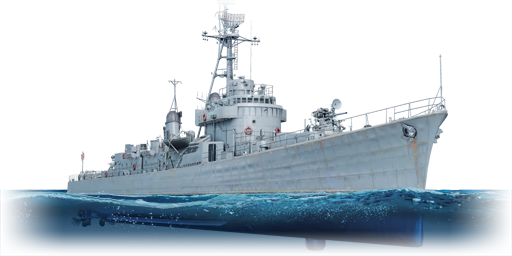

Coastal Fleet
Akebono
IV
Rank
AB
3.3
RB
3.3
Battle rating
Japan
Research country
Frigate
Main role
2,980

Purchase

Premium vehicle
Status
General information
Specification
Armour
Hull
16 mm (steel)
Superstructure
4 mm (steel)
Number of sections
6
Displacement
1,456 t
Crew
193 persons
Max speed
Forward
52457353 km/h
Backward
27233828 km/h
Primary armament
2 × Turret — 3-inch/50 Mk.34 gun
Ammunition
3,000 rounds
Belt capacity
150 rounds
Reload
basic crew → aces
13 → 10 s
Fire rate
50 shots/min
Vertical guidance
-15 / 85°
Turret Rotation Speed
Horizontal
2420.42420.4 °/s
Vertical
3025.53025.5 °/s
| Ammunition | Type | Armor penetration (mm) at a distance: | |||||
|---|---|---|---|---|---|---|---|
| 100 m | 1000 m | 2000 m | 3000 m | 4000 m | 5000 m | ||
| HE | 11 | 10 | 8 | 8 | 8 | 8 | |
| APHE | 121 | 101 | 86 | 76 | 68 | 62 | |
| HE-VT | 12 | 10 | 9 | 8 | 7 | 7 | |
Secondary armament
2 × 40 mm Bofors L/60 Mark 1 gun
Ammunition
4,000 rounds
Belt capacity
4 rounds
Reload
basic crew → aces
0.5 → 0.4 s
Fire rate
156 shots/min
Vertical guidance
-15 / 89°
Turret Rotation Speed
Horizontal
3025.53025.5 °/s
Vertical
2420.42420.4 °/s
| Belt | Belt filling | Armor penetration (mm) at a distance: | |||||
|---|---|---|---|---|---|---|---|
| 10 m | 100 m | 500 m | 1000 m | 1500 m | 2000 m | ||
| AP-T/HEFI-T | 81 | 78 | 69 | 61 | 55 | 50 | |
| AP-T/AP-T/AP-T/HEFI-T | 81 | 78 | 69 | 61 | 55 | 50 | |
| HEFI-T/HEFI-T/HEFI-T/AP-T | 81 | 78 | 69 | 61 | 55 | 50 | |
Additional armament
Setup 1
12 × Mk.6 depth charge
Setup 2
24 × Mk.10 "Hedgehog" mortar
20 × Mk.6 mortar depth charge
20 × Mk.6 mortar depth charge
Setup 3
24 × Mk.10 "Hedgehog" mortar
20 × Mk.6 mortar depth charge
12 × Mk.6 depth charge
20 × Mk.6 mortar depth charge
12 × Mk.6 depth charge
Economy
Repair cost
AB
3,689 

RB
5,306 

Crew training
10,000 

Experts
360,000 

Aces
820 

Research Aces
870,000 

Reward multiplier
AB / RB
 2 x (255 / 415) %
2 x (255 / 415) % 
 2 x 160 %
2 x 160 % 

Premium vehicle
All modifications are unlocked
Seakeeping |
|---|
Unsinkability | |
|---|---|
Firepower | ||
|---|---|---|
Rating by players
You must play more than 3 battles for the last week and more than 10 battles in a vehicle to rate it.
Like:
6
Armor protection:
Not enough ratings
Survivability:
Not enough ratings
Mobility:
Not enough ratings
Armament:
Not enough ratings
Balance:
Not enough ratings
Tips & Tricks
This space is currently empty
Do you know any interesting vehicle features?
Loading...
No articles about this vehicle yet
Become the first author and get rewards!
Write a guide, tell about interesting historical facts, make a tutorial or simply an interesting post.
No more content